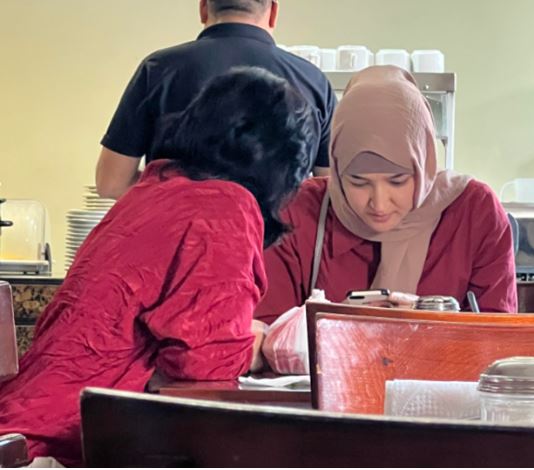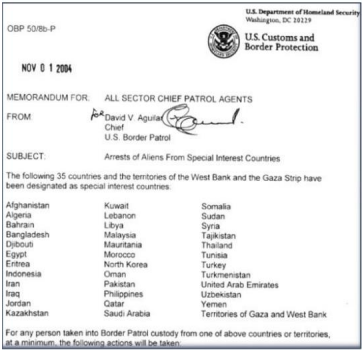The ‘CBP One’ phone app entry scheme has brought in 888 other Tajiks, plus thousands more,
from nations of terrorism concern

By Todd Bensman as published June 20, 2024 in The Daily Wire
A multi-state FBI counterterrorism wiretap sting has rolled up eight Tajikistani nationals in three cities who had entered over the U.S. Southwest Border and were plotting some sort of bombing.
On its own, what little is known about this terrible new consequence of President Joe Biden’s ongoing historic mass migration border crisis – a coordinated, large-cell infiltration attack on the homeland – ranked as startling enough to draw congressional demands for much more basic information than the administration will currently release.
“Unfortunately, the unacceptable security failures that have allowed individuals with terrorist ties to enter the United States through the Southwest Border have become an alarming pattern under the administration,” states a recent U.S. House Homeland Security Committee letter demanding the Biden administration disclose how it failed here.
Not yet demanded, however, is attention to a recent revelation about the Tajik Eight case that should propel what is happening at the border to an even higher and broader level of national security concern. NBC News has reported that the Department of Homeland Security (DHS), of all agencies, actually vetted and pre-approved the entry of at least one of the busted Tajikistanis on the administration’s “CBP One” phone app — a humanitarian parole scheme.
The CBP One phone app-based entry program has allowed more than 500,000 foreign nationals from 100 different countries who intended to illegally cross the border to instead schedule a DHS-approved “legal” escort through eight U.S.-Mexico land ports, according to information exclusively obtained and reported by the Center for Immigration Studies through Freedom of Information Act litigation over the past year.
The Biden administration began piloting the program in May 2021 but dramatically expanded it in January 2023, it said, as a means to clear politically damaging illegal entry border congestion.
Almost all 500,000, we are assured, were supposedly well vetted for security, then granted quick release into the United States, sight unseen, on two-year, renewable permits that also come with work authorization eligibility.
But the NBC revelation that one or more of the arrested Tajiks used the CBP One land ports entry scheme warrants new scrutiny about that land port pipeline into the country. It poses a unique national security risk, quite separate from traditional illegal border crossings, especially the vetting that is supposedly done byDHS before passage is granted.
In this case, the vetting obviously didn’t work.. But for how many others did the vetting system not work? The odds do not look promising.
It turns out that DHS personnel have approved not one or two problematic Tajiks of malintent for passage, but hundreds from that Muslim-majority country of U.S. terrorism concern over the past couple of years – and literally thousands from some two dozen other nations of terrorism concern, according to an analysis of the center’s FOIA lawsuit data on this program.
From its May 2021 inception through at least December 2023, DHS approved 888 Tajiks for land port passage and release into the country on the two-year humanitarian parole releases, no doubt many more during the first half of 2024.
And they are the least of a rich diversity of foreign nationals from two dozen nations of terrorism concern that the administration has wittingly allowed through the pipeline.
Thousands More Approved For Entry
The historical context as a homeland security matter for these entries is important to know. To reduce the risk of terrorist border infiltration a few years after 9/11, the U.S. homeland security enterprise began tagging those arriving from some 35-40 nations where Islamic terrorist groups operate as “special interest aliens,” or SIAs, which flagged them for detention and additional security vetting. The Biden administration now uses the term “special interest migrants” internally.
SIAs are not regarded as terrorists but, because they arrive from nations where avowed anti-U.S. terrorist groups are prevalent, homeland security protocols dating back to a 2004 CBP Memorandum required extra security procedures for those coming from the designated list of countries. Tajikistan has been on that list from the beginning.

U.S. Customs and Border Protection. November 1, 2004.
In addition to the 888 Tajiks allowed in through the CBP One app program, DHS has authorized thousands more from 24 special interest countries to enter, including from Afghanistan (653), and smatterings from Iran (27), Lebanon (10), Syria (7), Iraq (4), Egypt (6), and Jordan (5). But the largest numbers of SIAs let in are coming from other Muslim-majority former Soviet republics in Central Asia neighboring Tajikistan, such as Kyrgyzstan (4,224 through December), Uzbekistan (2,071), and Kazakhstan (585).
The terrorism section of the CIA’s “World Factbook” notes that U.S.-designated foreign terrorist groups have long operated in the dangerous neighborhood that all three of the most numerous of the SIAs hail from: the Kyrgyz Republic, Uzbekistan, and Tajikistan. Afghanistan is in the same tough neighborhood.
Among the groups operating in those three countries are the Islamic Jihad Union, the Islamic Movement of Uzbekistan, and ISIS-Khorasan (ISIS-K). But there are many other extremist groups operating in the region too, such as the Islamic Renaissance Party of Tajikistan and various ISIS-affiliated groups the government has suppressed, according to the U.S. State Department’s 2021 Country Report on Terrorism for Tajikistan, and who might want to flee to the United States.
The same report notes that terrorist group members move throughout the mostly unguarded borders of these countries, with Tajikistan asserting that “thousands of militants” come and go from neighboring Afghanistan.
As one indication of public sentiment toward Islamic extremist ideology in the Kyrgyz Republic, an estimated 850 of its citizens reportedly joined ISIS between 2013 and 2015, and regional scholars insist the real number is higher, according to George Washington University’s Program on Extremism.
Uzbekistan also has figured prominently in global counterterrorism efforts, in part because the internationally designated terrorist organization known as the Islamic Movement of Uzbekistan has had regional and global reach and regularly conducts attacks. Extremists from Uzbekistan have been implicated in U.S. attacks and plots too. Hundreds of Uzbeks also fought for ISIS and many have returned.
At issue with the entry of one or more of the Tajik Eight, along with the thousands of other government-authorized entries of SIAs, is whether the Biden administration’s DHS is conducting effective enhanced security screening.
Failing Security Screening
DHS Secretary Alejandra Mayorkas has repeatedly assured the American public that security vetting for this program is its highlight.
DHS policy documents say all approved CBP One applicants pass “rigorous biometric and biographic national security and public safety screening and vetting.”
CBP agents and U.S. processors, however, mainly run this information through criminal and domestic national security databases looking for matches to U.S. criminal records, warrants, and terrorism watch lists, those who do this work say. A DHS source with direct knowledge of government vetting processes for the CBP One land port parole program, who was not authorized to speak or be identified, told me last fall that all of the SIAs going through the CBP One appointment and parole at the land ports are run through more databases than non-SIA applicants — these ones containing classified intelligence information — as a means to detect terrorism problems.
But this vetting process is deeply flawed, experts say, because of a presumption that only fractional few real terrorists ever make intelligence databases. Database checks can’t detect information that is not in them.
“The only thing we can query is information that we have,” former FBI Director James Comey once said of vetting foreign national refugees. “So, if we have no information on someone, they’ve never crossed our radar screen, they’ve never been a ripple in the pond, there will be no record of them there and so it will be challenging.”
Neither can U.S. intelligence agencies very well check for derogatory information with governments that are diplomatically hostile to the United States and would never cooperate, such as Iran, Syria, Yemen, and Afghanistan.
Pertinent Questions
“That’s a really hard target to analyze, and to just shoot from the hip and let them in is absolute insanity in my book,” said James G. Conway, a retired FBI counterterrorism agent who after 9/11 worked in Mexico trying to detect terrorists within the SIA flows. “How would you knowingly and wittingly bring people from terrorist countries into the United States with that level of vetting? Some of these terrorism countries don’t even have an electric grid let alone a computer system, and you can’t scrub them on databases that don’t exist. The whole thing is insane to me.
“What’s the motivation? I mean, why would they do that?” Conway added, referencing the Biden administration’s approval of SIAs for the CBP One entry program.
That’s a pertinent question that lawmakers, media pundits, and reporters might start asking before there’s blood in American streets.